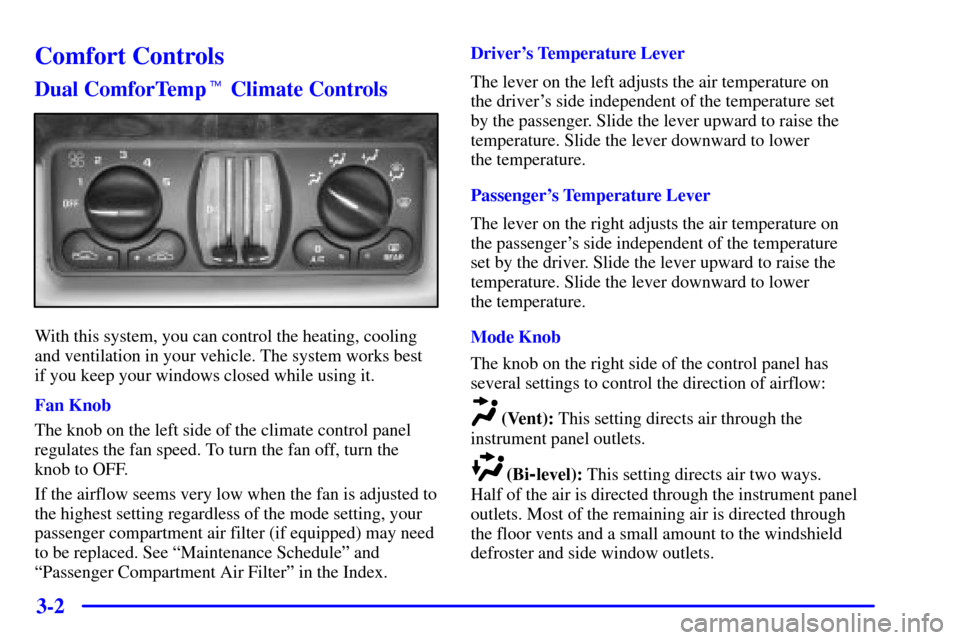Page 79 of 397
2-13
Resynchronization
After you have changed the battery in your transmitter,
you will need to resynchronize the transmitter. To do
this, press the LOCK and UNLOCK buttons on the
transmitter together and hold for approximately seven
seconds or until one brief horn chirp is heard.
Trunk
CAUTION:
It can be dangerous to drive with the trunk lid
open because carbon monoxide (CO) gas can
come into your vehicle. You can't see or smell
CO. It can cause unconsciousness and even death.
If you must drive with the trunk lid open or if
electrical wiring or other cable connections must
pass through the seal between the body and the
trunk lid:
�Make sure all other windows are shut.
�Turn the fan on your heating or cooling
system to its highest speed with the setting
on VENT. That will force outside air into
your vehicle. See ªComfort Controlsº in
the Index.
�If you have air outlets on or under the
instrument panel, open them all the way.
See ªEngine Exhaustº in the Index.
Page 154 of 397
2-88 Engine Coolant Temperature Gage
United States-3400 V6
Engine ClusterUnited States-3800 V6
Engine Cluster
Canada-3400 V6
Engine ClusterCanada-3800 V6
Engine ClusterThis gage shows the engine coolant temperature.
It also provides an indicator of how hard your vehicle is
working. During the majority of the operation, the gage
will read 210�F (100�C) or less.
If you are pulling a load or going up hills, it is normal
for the temperature to fluctuate and approach the 250�F
(122�C) mark. When the gage reads greater than 250�F
(122�C), the HOT COOLANT TEMP light will be
illuminated in the message center and a chime will
sound continuously. If the gage reaches the 260�F
(125�C) mark, it indicates that the cooling system is
working beyond its capacity.
See ªEngine Overheatingº in the Index.
Page 162 of 397
2-96
Hot Coolant Temp
United States Canada
This message is displayed when the cooling system
temperature gets hot. A chime will sound
continuously, also.
Check the coolant temperature gage and the coolant
level. See ªEngine Coolant,º ªEngine Coolant
Temperature Gageº and ªEngine Overheatingº in the
Index for further information.Low Coolant LevelUnited States Canada
This message is displayed when the cooling system is
low on coolant. Four chimes will also sound.
The engine may overheat. See ªEngine Coolantº in the
Index and have your vehicle serviced as soon as you can.
Page 174 of 397

3-2
Comfort Controls
Dual ComforTemp� Climate Controls
With this system, you can control the heating, cooling
and ventilation in your vehicle. The system works best
if you keep your windows closed while using it.
Fan Knob
The knob on the left side of the climate control panel
regulates the fan speed. To turn the fan off, turn the
knob to OFF.
If the airflow seems very low when the fan is adjusted to
the highest setting regardless of the mode setting, your
passenger compartment air filter (if equipped) may need
to be replaced. See ªMaintenance Scheduleº and
ªPassenger Compartment Air Filterº in the Index.Driver's Temperature Lever
The lever on the left adjusts the air temperature on
the driver's side independent of the temperature set
by the passenger. Slide the lever upward to raise the
temperature. Slide the lever downward to lower
the temperature.
Passenger's Temperature Lever
The lever on the right adjusts the air temperature on
the passenger's side independent of the temperature
set by the driver. Slide the lever upward to raise the
temperature. Slide the lever downward to lower
the temperature.
Mode Knob
The knob on the right side of the control panel has
several settings to control the direction of airflow:
(Vent): This setting directs air through the
instrument panel outlets.
(Bi-level): This setting directs air two ways.
Half of the air is directed through the instrument panel
outlets. Most of the remaining air is directed through
the floor vents and a small amount to the windshield
defroster and side window outlets.
Page 176 of 397

3-4 Air Conditioning
On very hot days, open the windows long enough to
let hot, inside air escape. This reduces the time for the
vehicle to cool down. Then keep your windows closed
for the air conditioner to work its best.
For quick cool down on very hot days select a fan
setting, turn the mode knob on the control panel to vent;
press the A/C and the recirculation buttons and move the
temperature controls all the way into the blue area. If
this setting is used for long periods of time, the air in
your vehicle may become too dry.
For normal cooling on hot days, turn the mode knob
on the control panel to vent; press the A/C and the
outside air buttons and move the temperature control all
the way into the blue area. The system will bring in
outside air and cool and dehumidify it.
On cool, but sunny days, the sun may warm your upper
body, but your lower body may not be warm enough.
To remedy this you can select a fan setting, turn the
mode knob on the control panel to the bi
-level mode,
press the A/C button, and move the temperature control
to a comfortable setting.
Heating
On cold days, select a fan setting, turn the mode knob on
the control panel to floor, press the outside air button on
and move the temperature control all the way in the red
area. The system will bring in outside air, heat it and
send it to the floor ducts.
Ventilation
For mild outside temperatures when little heating or
cooling is needed, select a fan setting and turn the mode
knob on the control panel to vent. Press the outside
air button and move the temperature controls to a
comfortable setting. Your vehicle also has the
flow
-through ventilation system described later
in this section.
Defogging and Defrosting
Your system has two settings for clearing the front and
side windows. To defrost the windows quickly, use
defroster with the temperature controls all the way in the
red area. To warm passengers while keeping the
windows clear, use defogger. For more information,
see ªRecirculationº in the Index.
Page 237 of 397

4-25
If you drive regularly in steep country, or if you're
planning to visit there, here are some tips that can make
your trips safer and more enjoyable.
�Keep your vehicle in good shape. Check all fluid
levels and also the brakes, tires, cooling system
and transaxle. These parts can work hard on
mountain roads.
�Know how to go down hills. The most important
thing to know is this: let your engine do some of
the slowing down. Shift to a lower gear when you
go down a steep or long hill.
CAUTION:
If you don't shift down, your brakes could get
so hot that they wouldn't work well. You would
then have poor braking or even none going
down a hill. You could crash. Shift down to let
your engine assist your brakes on a steep
downhill slope.
CAUTION:
Coasting downhill in NEUTRAL (N) or with the
ignition off is dangerous. Your brakes will have to
do all the work of slowing down. They could get
so hot that they wouldn't work well. You would
then have poor braking or even none going down
a hill. You could crash. Always have your engine
running and your vehicle in gear when you
go downhill.
�Know how to go uphill. You may want to shift down
to a lower gear. The lower gears help cool your engine
and transaxle, and you can climb the hill better.
�Stay in your own lane when driving on two
-lane
roads in hills or mountains. Don't swing wide or cut
across the center of the road. Drive at speeds that let
you stay in your own lane.
�As you go over the top of a hill, be alert. There could be
something in your lane, like a stalled car or an accident.
�You may see highway signs on mountains that warn of
special problems. Examples are long grades, passing or
no
-passing zones, a falling rocks area or winding
roads. Be alert to these and take appropriate action.
Page 253 of 397

4-41 When You Are Ready to Leave After
Parking on a Hill
1. Apply your regular brakes and hold the pedal down
while you:
�start your engine,
�shift into a gear, and
�release the parking brake.
2. Let up on the brake pedal.
3. Drive slowly until the trailer is clear of the chocks.
4. Stop and have someone pick up and store the chocks.
Maintenance When Trailer Towing
Your vehicle will need service more often when you're
pulling a trailer. See the Maintenance Schedule for more
on this. Things that are especially important in trailer
operation are automatic transaxle fluid (don't overfill),
engine oil, drive belts, cooling system and brake system.
Each of these is covered in this manual, and the Index
will help you find them quickly. If you're trailering, it's
a good idea to review this information before you start
your trip.
Check periodically to see that all hitch nuts and bolts
are tight.
Engine Cooling When Trailer Towing
Your cooling system may temporarily overheat during
severe operating conditions. See ªEngine Overheatingº
in the Index.
Page 254 of 397
5-
5-1
Section 5 Problems on the Road
Here you'll find what to do about some problems that can occur on the road.
5
-2 Hazard Warning Flashers
5
-2 Other Warning Devices
5
-3 Jump Starting
5
-10 Towing Your Vehicle
5
-10 Engine Overheating5
-13 Cooling System
5
-23 If a Tire Goes Flat
5
-23 Changing a Flat Tire
5
-35 Compact Spare Tire
5
-36 If You're Stuck: In Sand, Mud, Ice or Snow